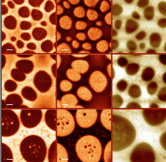
Mapping the Nanoscale Landscape: Scanning transmission X-ray microscopy (STXM) maps of chemical structure of polymer photovoltaic fims
The Australian soft X-ray community proposes to establish a Soft X-ray Cluster that encompasses a new undulator beam line and bending magnet beam line facility.
- The new undulator beamline will be optimised for micro-focus, imaging soft X-ray spectroscopy comprising a "Super-STXM" endstation.
- Combining STXM-AFM capabilities simultaneously on the same sample
- Introducing new zone plate advances to achieve sub-10 nm resolution
- The new bending magnet beam line will have up to three branch lines to cover the 10 eV up to 1500 eV energy range. One line would be able to accommodate the new toroidal analyser and another to cover possibly general XAS and/or full field microscopy.
Longer term objectives include:
- Developing the XPEEM and LEEM community followed by the acquisition of an SPELEEM end station.
- Access to "tender" photon energies, e.g. up to 4keV on a bending magnet beamline
There is very strong support for the development of a new Soft X-ray beam line cluster as part of the bid for the next suite of beam lines at the AS.
- Synchrotron-based soft X-ray microscopy and spectroscopy are unique techniques for mapping and analysing the chemical composition of surfaces with sub 30 nanometre resolution and sub 0.1% sensitivity.
- There is a large and growing Australian Soft X-ray community across the full range of science and technology disciplines encompassing Physics, Chemistry, Biology, Geology, Geochemistry and Mineralogy amongst others
- A driver for the growth of this community is the ability of soft x-ray microscopy to provide quantitative chemical maps of surfaces with unprecedented resolution
- The present soft X-ray beam line is heavily oversubscribed, thus providing a strong case for additional spectroscopy and microscopy based soft X-ray beam-lines.
- Although applicable to a wide range of materials, the capabilities of soft X-ray spectroscopy and microscopy are particularly relevant to organic and biomaterial surfaces where it is now possible to differentiate materials on the basis of subtle differences in molecular structure rather than crude elemental composition.
![]() Download Full Project Proposal Here (pdf, 160kb)
Download Full Project Proposal Here (pdf, 160kb)
Contact Paul Dastoor
Position: Director Centre for Organic Electronics, University of Newcastle
Phone: +61 (0)2 4921 5426
Fax: +61 (0)2 4921 6907
Email: [email protected]
Further Information
- Contact Andrew Peele or Kia Wallwork at [email protected].











